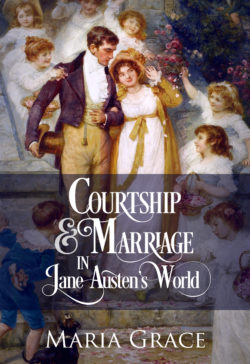Making Introductions in Jane Austen’s World

In Pride and Prejudice, Mr. Collins mortified Elizabeth Bennet at the Netherfield ball. His transgression? He introduced himself to Mr. Darcy and conversed with him. But why would introductions–or more specifically not having a formal one-have bothered her?
All About the Reputation
During the Regency era, a young woman’s reputation could determine her future. A reputation could be marred by something as simple as an immodest fall while exiting a carriage. Mary Bennet was not exaggerating when she lectured her sisters: a woman’s reputation is as brittle as it is beautiful. A good reputation was essential to making a good marriage – the making or breaking of their future life. So a woman had to pay close attention to all aspects of etiquette.
As if she didn’t already have enough to worry about.
Formal introductions helped protect women’s reputations. They controlled who might be allowed to interact with said young lady. So, that annoying guy at the grocery store, the one you’ve never seen before but who insists on trying to hold a conversation when all you want to do it by your chocolate covered chickpeas? Well he would be the epitome of all that was improper. You could turn up your nose and walk away. And everyone would say you had done the right and proper thing!
Obtaining an Introduction
Today one can introduce themselves to a potentially interesting stranger and strike up a conversation. During the regency, proper ladies and gentlemen required a formal introduction by a mutual acquaintance before they could interact.
Neighborhood matrons, and parsons’ wives, with their wide range of connections, were an excellent source of introductions. The Middletons of Austen’s Sense and Sensibility play this role for the Dashwood sisters. No doubt Augusta Elton of Emma would have thoroughly enjoyed this aspect of her position as the vicar’s wife. Public and private events including dinners and parties, feasts, festivals, even wakes, provided opportunities for introductions.
Lack of introductions could prove a problem at a public ball. A lady could not receive an invitation to dance from an unfamiliar gentlemen. Never fear though, the ballroom’s Master of Ceremonies could introduce gentlemen and ladies to enable them to dance, though he might not be acquainted with either party. In Northanger Abbey, Henry Tilney fetches the Master of Ceremonies who introduces him to Catherine and and Mrs. Allen. Afterwards they may converse freely about muslins. What a gentleman!
Making an Introduction

Introduction could not be made without permission. Afterall, that could bring people of quality ‘inconvenient’ connections. (Mary Elliot complained of these in Persuasion, but as they were also related to her by marriage, she could not refuse them. Poor dear.) The higher ranking individual (or the woman in the case of two equally ranking individuals) could permit the introduction of an inferior–or not.
If the higher ranking person did not desire an introduction, one could not be forced upon them. Imagine the imposition of an undesirable thinking they could just walk up and talk to you! The indignity!
In some circumstances, the higher ranking person could introduce him or herself to the lower one. One of lower rank NEVER introduce themselves to someone of higher rank, that would be not just arrogant, but an imposition on the higher ranked person. No wonder Elizabeth Bennet was horrified when Mr. Collins struck up a conversation with Mr. Darcy without a proper introduction, in Pride and Prejudice.
After being introduced, individuals were considered acquaintances and ALWAYS acknowledged each other in public. At minimum, a gentleman would tip or touch his hat. A lady would offer a slight bow of the shoulders. Failure to recognize an acquaintance was considered a cut. Conduct manuals warned that a lady should never ‘cut’ someone unless ‘absolutely necessary.’ (I would probably be in serious trouble for the number of times I’ve accidently walked past someone I knew without even realizing it. Ouch!)
A Good Reason to Require Introductions

Though it seems awkward, introductions allowed young ladies to control social interactions. The men had the power of “chusing whom they may address, and (women) of rejecting whom they may dislike.” (Gener, 1812).
Younger sons not eligible to inherit the family estate often pursued heiresses for their fortunes. One such man, under the pen name of ‘A Younger Brother’, went so far as to publish, A Master-Key to the Rich Ladies Treasury or The Widower and Batchelor’s Directory in 1742.
The book contained a list of London heiresses, their expected fortune and the general location of their residence. The Younger Brother advised:
“Thus Gentlemen, have I in the following Sheets I think, opened a fair Field for Action for you; a fine Choice and a fine Collection of Ladies; — Open the Campaign directly then yourselves, that my next may be a new Sett. I have one favour to beg of you, and then I take my Leave; that no one of you, of what Degree soever, presume to attempt the Lovely Charmer I dedicate to; as to the Rest, I heartily wish you all Success …”
Brings to mind several of Austen’s less noble men: Wickham, Willoughby, William Elliot.
Find References Here!
To Read more articles on weddings, click here.
To read more articles on courtship click here.
To read more articles on marriage click here.
Want to learn more? Try Courtship and Marriage in Jane Austen’s World, available in ebook and paperback.
.
Please support this author and website by using this affiliate link.

Just received your book in the post Maria and I can’t wait to dive in. It looks great and I love the cover. I always like to have this type of book in physical form.
Awesome Teresa! I hope you enjoy it!